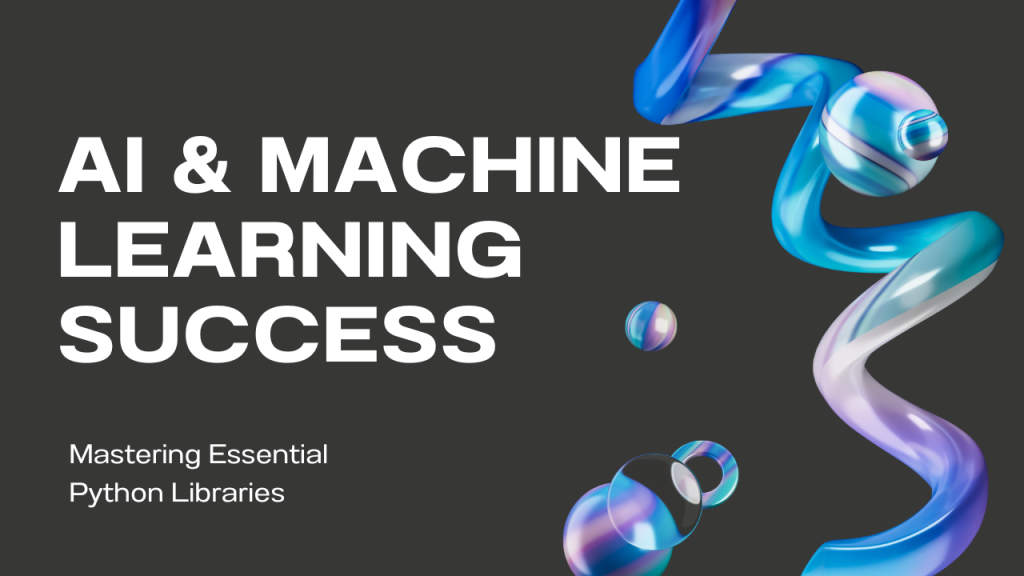
Unlocking the Power of Python for Data Science
Are you a data science student or a professional looking to make a career switch into the exciting world of AI and machine learning? If so, you’re in the right place! Today, we’re diving deep into the essential Python libraries that form the backbone of modern data science and machine learning projects. These powerful tools are not just nice-to-haves; they’re must-knows for anyone serious about pursuing an AI ML certification or enrolling in an online machine learning course.
Why Python Libraries Matter in AI and ML
Before we get into the specifics, let’s address the elephant in the room: Why should you care about these libraries? The answer is simple. In the rapidly evolving field of data science, these libraries are your secret weapons. They can dramatically reduce the time and effort required to perform complex calculations, manipulate data, and build sophisticated machine-learning models. Mastering these libraries isn’t just about adding skills to your resume; it’s about transforming how you approach data problems.
NumPy: The Foundation of Numerical Computing
What is NumPy?
NumPy, short for Numerical Python, is the cornerstone of scientific computing in Python. It supports large, multi-dimensional arrays and matrices, along with a vast collection of high-level mathematical functions to operate on these arrays.
Why NumPy is Crucial for Your AI ML Journey
- Efficient array operations
- Powerful broadcasting capabilities
- Essential for data preprocessing in machine learning
“NumPy is to Python what a calculator is to mathematics. It’s an indispensable tool that makes complex calculations simple and fast.”
Learning NumPy is often the first step in any online AI ML certification program. Its efficiency in handling large datasets makes it a fundamental skill for aspiring data scientists.
Pandas: Your Data Manipulation Swiss Army Knife
Introducing Pandas
Pandas take data manipulation to the next level. It provides data structures like DataFrames that allow you to work with structured data seamlessly.
The Power of Pandas in Machine Learning
- Efficient data cleaning and preprocessing
- Easy handling of missing data
- Powerful data aggregation and transformation tools
Pandas is a game-changer regarding data preparation, a critical step in any machine learning pipeline. Its intuitive interface makes it a favorite among data scientists and a key component of online machine-learning courses.
Scikit-learn: Machine Learning Made Accessible
Demystifying Scikit-learn
Scikit-learn is the go-to library for classical machine learning algorithms. It provides a consistent interface for various ML techniques, from simple linear regression to complex ensemble methods.
Why Scikit-learn is Essential for Your AI ML Toolkit
- Comprehensive suite of machine learning algorithms
- Consistent API across different models
- Excellent documentation and community support
For those pursuing an AI ML certification, Scikit-learn is often the library where theory meets practice. Its user-friendly design makes it perfect for both beginners and experienced practitioners.
TensorFlow: Deep Learning at Your Fingertips
The Power of TensorFlow
TensorFlow, developed by Google, is a powerhouse for deep learning and neural networks. It’s designed for large-scale machine learning and numerical computation.
TensorFlow’s Role in Advanced AI Applications
- Flexible ecosystem for building complex neural networks
- Excellent for both research and production environments
- Powerful visualization tools with TensorBoard
Many online machine learning courses dedicate significant time to TensorFlow, as it’s a crucial tool for anyone serious about deep learning and AI.
PyTorch: Dynamic Deep Learning
Understanding PyTorch
PyTorch, developed by Facebook’s AI Research lab, offers dynamic computational graphs and eager execution, making it particularly popular in research settings.
Why PyTorch is Gaining Traction in AI Research
- Dynamic computation graphs for flexible model building
- Intuitive, Pythonic interface
- Strong community and growing ecosystem of tools
While TensorFlow has been the industry standard, PyTorch is quickly gaining ground, especially in academic and research environments. Many AI ML certification programs now include PyTorch alongside TensorFlow.
Integrating These Libraries in Your AI ML Journey
Now that we’ve explored these essential libraries, you might wonder how to incorporate them into your learning journey best. The key is practice and application. Here’s a suggested approach:
- Start with NumPy and Pandas to build a strong foundation in data manipulation.
- Move on to Scikit-learn to apply classical machine learning algorithms to real-world problems.
- Dive into TensorFlow and PyTorch for deep learning applications.
Remember, the best way to learn is by doing. Work on projects that utilize these libraries as you progress through your online machine learning course or AI ML certification program.
The Road Ahead: Your AI ML Certification Journey
Becoming a proficient data scientist or AI specialist can seem daunting, but it’s an exciting and rewarding journey with the right tools and knowledge. These Python libraries are not just tools but your innovation and discovery partners.
By mastering these libraries, you’re not just learning to code; you’re equipping yourself with the ability to solve complex real-world problems, analyze vast amounts of data, and create intelligent systems that can transform industries.
As you consider your next steps, whether enrolling in an online machine learning course or pursuing an AI ML certification, remember that proficiency in these libraries will set you apart in a competitive field. They are the building blocks upon which you’ll construct your AI and machine learning career.
So, are you ready to take the plunge? The world of AI and machine learning is waiting, and with these powerful Python libraries at your fingertips, you’re well-equipped to make your mark. Start your journey today, and who knows? The next breakthrough in AI might just come from you.


